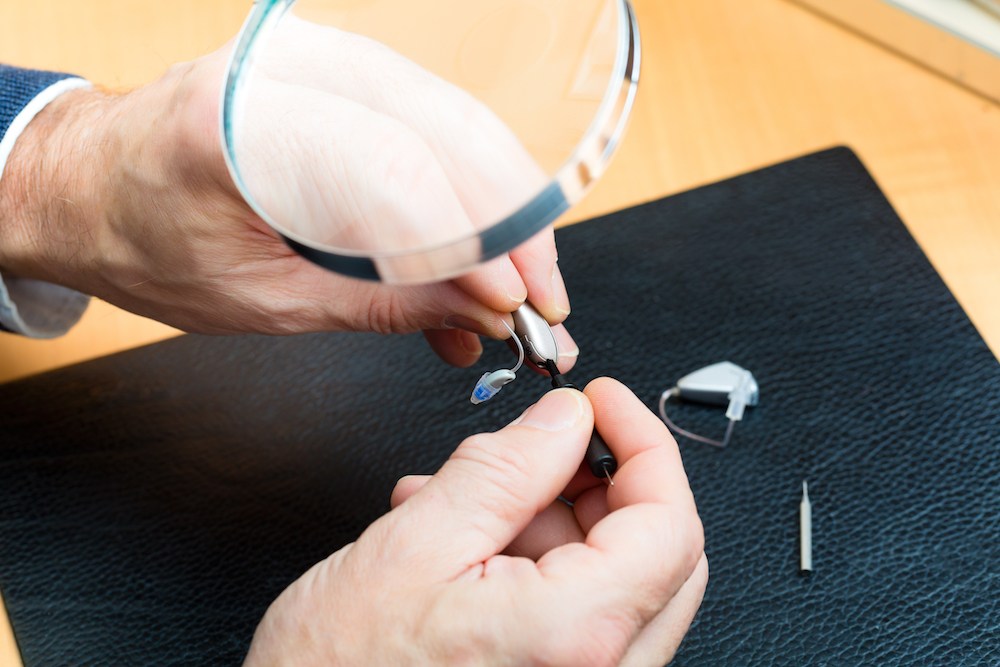The Future of Hearing Aid Personalization
Hearing aid technology is moving toward treating each person’s

By: admin | January 26, 2025
Winter weather brings unique challenges when you wear hearing aids. The cold temperatures, snow and constant shifts between outdoor chill and indoor heat can affect how well these important devices work. Your hearing aids help you stay connected to the world around you – from talking with your family at dinner to hearing important announcements at work or school. When moisture gets into your hearing aids, it can interrupt these daily moments that matter.
We often think about protecting ourselves from winter weather by bundling up in coats and scarves, but your hearing aids need protection too. Just like other electronic devices, they can be sensitive to moisture and temperature changes.
You depend on your hearing aids to work reliably every day. Taking steps to protect them from winter moisture helps ensure they keep working properly, so you can focus on enjoying the season rather than worrying about your hearing.
Hearing aids are designed to help people with hearing loss by amplifying sound and making it easier to hear and understand speech. They work by collecting sound from the environment using a microphone, processing that sound with advanced technology and delivering it to the ear through a speaker. Modern hearing aids are highly customizable, allowing adjustments to match the specific type and degree of hearing loss. F
Today’s hearing aids also come with advanced features that improve their functionality and convenience. Many include directional microphones that focus on sounds coming from a specific direction, like someone speaking directly to you in a crowded room. Others offer noise reduction technology to minimize background noise, making it easier to follow conversations. Some models connect wirelessly to smartphones or other devices, allowing users to stream phone calls, music or TV audio directly to their hearing aids. These features make hearing aids more effective and user-friendly, helping individuals stay engaged in their daily lives.
Moisture can significantly affect hearing aid performance, and it’s important to understand how different environmental conditions, like snow, frigid temperatures and humidity, can impact these devices. Hearing aids are electronic devices with delicate components, like microphones, receivers and circuit boards, which can be vulnerable to moisture. When exposed to snow or rain, water can seep into the device and interfere with its functionality, leading to static, muffled sound or even complete shutdown in severe cases. Similarly, frigid temperatures can cause condensation to form when you move between cold outdoor air and warm indoor spaces. This moisture buildup inside the hearing aids can lead to corrosion or damage to internal parts over time.
To protect hearing aids from moisture, it’s essential to take preventive measures. For example, wearing a hat or headband in snowy or cold conditions can help shield the devices from direct exposure to precipitation. When indoors, using a hearing aid dehumidifier or drying kit can remove moisture that may have accumulated during the day, especially in humid or snowy climates. Regular cleaning and maintenance are also crucial for preventing issues caused by moisture. By staying proactive, you can ensure your hearing aids function optimally, even in challenging weather conditions.
Snow, rain and freezing temperatures can expose hearing aids to moisture, which may lead to performance issues or long-term damage. To minimize exposure, wear protective accessories like hats, scarves or headbands that cover your ears when you’re outside. These not only shield your devices from snow and rain but also help reduce the risk of condensation forming as you transition between cold outdoor air and warm indoor spaces. For additional protection, consider using hearing aid sleeves or covers designed to repel moisture without affecting sound quality.
While you’re taking precautions to protect your hearing aids from winter moisture, it’s equally important to recognize signs of moisture damage. Early detection can help you take immediate action and prevent further harm to your devices.
Inconsistent performance is a common sign of moisture damage. If your hearing aids are cutting in and out or suddenly stop working, this could be due to water intrusion. Another sign is distorted or muffled sound quality. Any changes in the sounds you’re hearing could be due to water droplets interfering with sound waves inside your devices.
Physical changes can also indicate moisture damage. Look for signs of corrosion on the battery contacts or any other metal parts of your hearing aids. This could appear as discoloration or a chalky residue.
Winter elements like cold temperatures and wind can also have a significant impact on hearing aids. Freezing temperatures can affect the batteries in your devices, causing them to drain more quickly than usual. This happens because cold weather slows down the chemical reactions inside the battery, reducing its efficiency. If you rely on disposable batteries, you might notice the need to replace them more often, while rechargeable hearing aids may require more frequent charging. Additionally, the wind can create excessive noise in your hearing aids’ microphones, making it harder to hear clearly. This can be particularly frustrating when trying to have conversations outdoors or listen to important sounds.
To protect your hearing aids from the cold and wind, it’s helpful to wear protective clothing like earmuffs or a snug hat that covers your ears. These not only keep you warm but also act as a buffer against the wind and extreme cold. To combat battery issues, try keeping spare batteries in a warm place, like an inside coat pocket, to ensure they stay at an optimal temperature before use. If you use rechargeable devices, make sure they’re fully charged before heading out in the cold. Regularly inspecting your hearing aids for signs of wear or damage caused by winter conditions can help you address any problems early and maintain their performance throughout the season.
Certain types of hearing aids are more prone to the effects of winter humidity than others. Particularly, behind-the-ear (BTE) and in-the-ear (ITE) models can be more vulnerable due to their exposure to the external environment.
These models, with their exterior-facing components, have a higher risk of encountering moisture from winter elements like snow or rain. Additionally, condensation from temperature fluctuations is also a common issue with these devices.
To protect your BTE or ITE hearing aids this winter, consider investing in protective gear like hearing aid covers or sweatbands. These accessories provide an extra layer of defense against moisture while still allowing sound to pass through for optimal performance. Also, ensure you maintain regular cleaning and drying routines for your devices to keep them functioning at their best despite the cold weather conditions.
Proper maintenance is essential to keep your hearing aids functioning effectively and prolong their lifespan. Daily care routines not only ensure optimal performance but also help prevent damage from everyday wear and environmental factors like moisture, dust or earwax buildup. One of the most important maintenance tasks is cleaning your hearing aids. Use a soft, dry cloth to wipe the devices at the end of each day and regularly check the microphone openings and receivers for any debris. A small cleaning brush or wax pick, often included with your hearing aids, can help gently remove blockages without causing damage.
Moisture management is another critical part of hearing aid maintenance. Hearing aids are vulnerable to water and humidity, which can corrode their delicate internal components. Consider investing in a hearing aid dehumidifier or drying kit to remove moisture that may accumulate throughout the day, especially if you live in a humid or cold climate. If your hearing aids are exposed to sweat, rain or snow, dry them immediately with a soft cloth and avoid using heat sources like hair dryers, as they can damage the devices.
Battery care is also vital for ensuring your hearing aids operate smoothly. If you use disposable batteries, store them in a cool, dry place and replace them as needed. Remove the batteries from your hearing aids at night to prevent unnecessary drainage and to allow any trapped moisture in the battery compartment to evaporate. For rechargeable hearing aids, follow the manufacturer’s charging guidelines to avoid overcharging or letting the battery completely deplete, as this can affect long-term performance.
Lastly, schedule regular checkups with your audiologist. Routine maintenance appointments allow a professional to inspect and deep-clean your devices, address any performance issues and ensure they are programmed correctly for your hearing needs. Following these essential maintenance routines can help keep your hearing aids in top condition, allowing you to enjoy clear, reliable sound for years to come.
Maintaining your hearing aids during the winter can be easier with the right accessories designed to protect them from cold weather, moisture and debris. One of the most useful tools is a hearing aid dehumidifier or drying kit. These devices remove excess moisture that accumulates from snow, rain or condensation caused by moving between cold outdoor air and warm indoor spaces. Dehumidifiers are available in both electric and non-electric forms, making them a convenient option for daily use at home or while traveling.
Protective covers or sleeves for your hearing aids are another great accessory for winter care. These covers are designed to shield your devices from water, dirt and wind while still allowing clear sound transmission. They are especially helpful if you spend time outdoors in snowy or windy conditions, as they act as an additional layer of defense against the elements.
Carrying cases with moisture-resistant linings can also be invaluable during winter. These cases not only provide a safe place to store your hearing aids when not in use but also help keep them dry in humid or wet environments. For those using disposable batteries, battery storage containers are a must-have. They keep spare batteries safe and dry, ensuring they remain functional despite cold temperatures.
Winter weather can be tough on your hearing aids, but with the right care, you can keep them working smoothly through the season. Your hearing aids play an important role in helping you stay connected – whether you’re catching up with family over a warm meal, hearing announcements at school or work or simply enjoying the crisp sounds of the season. Protecting them from cold temperatures and moisture ensures they continue to support you in all the moments that matter.
If you’re unsure how to best care for your hearing aids this winter, HEARINC. is here to help. Whether you need advice, accessories or a professional checkup, we’re just a phone call away. You can reach us in Akron at (330) 752-6763 or in North Canton at (234) 356-3071. With the right support, your hearing aids will keep working reliably, so you can focus on enjoying everything winter has to offer.
Tags: hearing aid basics, hearing aid repair, hearing aid styles

Hearing aid technology is moving toward treating each person’s
By: admin | November 18, 2025

Children with hearing loss face obstacles that adults simply don’t
By: admin | September 24, 2025

When you lead an active life, your hearing aids need to keep up with you.
By: admin | May 23, 2025
